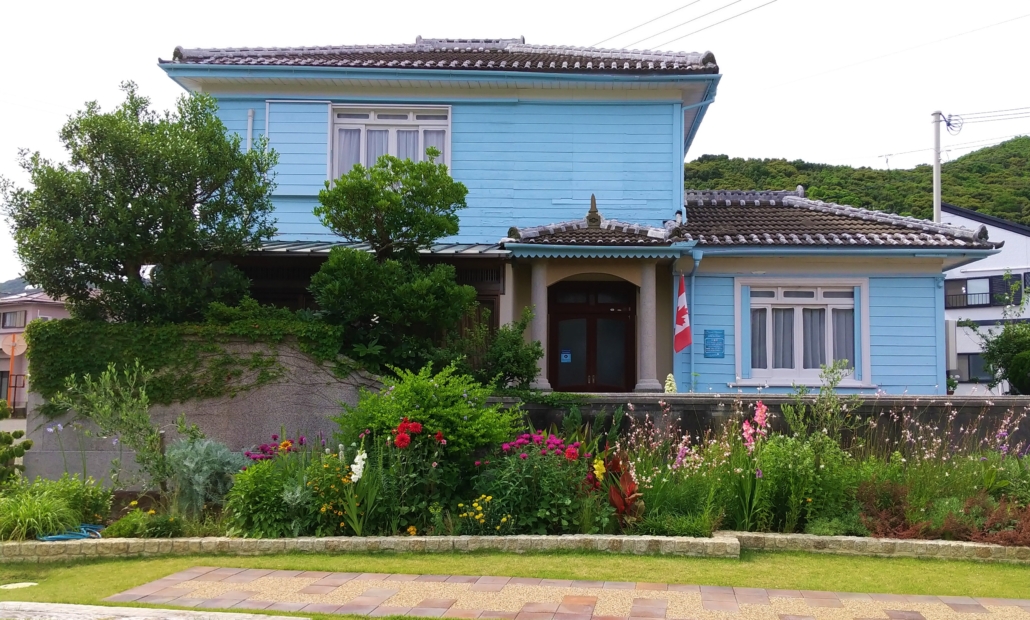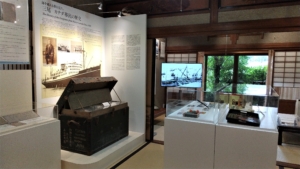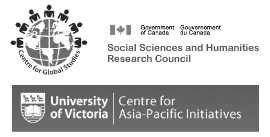Meet our Partners – The Mio Canada Museum


The village of Mio, a fishing village of five-hundred-odd residents located at the western end of Mihama Town in the Hidaka region of Wakayama Prefecture, Japan, does not strike one at first glance as a hub of transnational connection. Yet since the 1950s, numerous scholars have flocked to this corner of the Kansai Region to understand the history of what was at one time the main entrepot of Japanese emigration to Canada.
Emerging from the America-mura bus stop, one observes a pale blue North American craftsman-style house with traditional Japanese roof. This home was constructed circa 1934 by one Kannosuke Nakatsu a returnee from Canada. The building work itself was done by a local carpenter named Fujigusu Mio, known for his work building similar half-western, half Japanese houses in the area. Such homes came to so proliferate in the early twentieth century that the area duly earned the nickname ‘America-mura,’ the ‘American village.’ After several changes in the ownership of this particular house, Suguru Noda, a second-generation Japanese Canadian with roots in the Mio area, returned to Japan and began living in it in 1971. Shortly before his death, Mr. Noda donated the house to the town of Mihama in 2017. The following year, it was transformed into the Canada Museum, which conveys the emigrant culture of the time, and became a nationally registered tangible cultural property in 2019. The house today forms the locus of a network of local preservation and revitalization for the history linking British Columbia and Wakayama.
The story the Canada Museum tells stretches back to 1888, when a local villager by the name of Gihei Kuno emigrated to the BC fishing village of Steveston, near Vancouver. Gihei was the first person from Wakayama Prefecture to migrate to Canada, where he contributed to the Canadian fishing and cannery industry. His stories of abundant salmon fishing on the Fraser River instigated a wave of migration, which by the turn of the century saw over 1,500 Mio residents having left for Steveston and surrounds. 135 years have passed since Gihei Kuno’s first arrival in Canada, and the Mio district is currently facing a serious decline in birthrates and an aging population. More than 60% of the population in Mio is over 65 years old, with fewer than twenty people aged eighteen and below.
Mio has benefitted from the work of renowned local historians, such as Shigeharu Koyama and Hisakazu Nishihama, who were known as the directors of the America-mura Canada Migrant Resources Center (America-mura Kanada Imin Shiryo-kan) which was established in 1978 in Hinomisaki. Closed in 2015, the center’s mission has been taken up by this new Canada Museum. Inaugurated in 2018, the Specified Nonprofit Corporation Hinomisaki America-mura runs the Canada Museum, as well as the Yushin-an guest house, the Sutebusuton (‘Steveston’ as rendered in katakana or romaji) restaurant, and the ‘Let’s Kataribe’ Project, which instructs local children in both local heritage and English-language conversation skills.
The director of the Canada Museum, Takae Mio, explains that, because the current inhabitants of Mio are four or five generations removed from the original emigrants, “at first glance, you might not be able to see that really strong connection. But once you speak to locals, and once you walk around the community, you will find a lot of houses which sent a lot of immigrants to Canada.” Her own great aunt, for example, emigrated to Canada and remained there after the Pacific War. Her husband’s mother, meanwhile, was born in Steveston but returned to Japan before the war.
Currently, the Canada Museum provides students and visitors from both Japan and abroad opportunities to learn about the history and stories of emigrants from Mio. Further, it serves as a platform for research networks based on transnational Nikkei experience. For example, the From Mio Collaboration consists of a Canadian and Japanese group of scholars, museum professionals, community-based knowledge-holders, and local activists working together to illuminate the history and legacy of pre-World War II Japanese migration from Mio, Wakayama to coastal British Columbia. The Canada Museum also strives to be a global partner, contributing to the Past Wrongs, Future Choices Project through the traveling exhibit ‘Broken Promises’ and the creation of teachers’ resources and fieldwork materials.
Mrs. Mio declares, “This little museum, despite the size and despite the limited resources, strives to distill local pride in future generations: to keep telling the family histories, the local histories to the next generation.”
This article was written by Aaron Stefik, based on an interview with museum director Takae Mio, translated by Sachiko Kawakami

 Instagram
Instagram